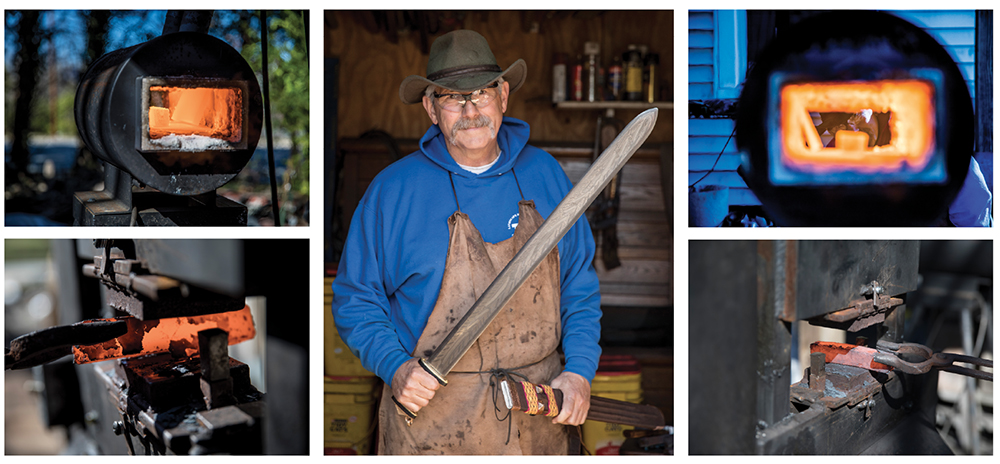
Iron Man
Mark Green’s calling to ancient arms
By Ross Howell Jr. • Photography by Bert VanderVeen

Ask Mark Green — a landscape professional in Greensboro since 1986 — what he enjoys doing most, and you’ll get an unusual answer.
“I like making swords from dirt,” Green says.
A native of Rockport, Massachusetts, Green first came to North Carolina to train with the U.S. Army 82nd Airborne Division at Fort Bragg. After service in Vietnam, he attended UNCG from 1979 to 1983, studying business and art.
“Unusual fields of study to combine, I guess,” Green says. “But my dad was a builder, and as a kid, it seemed like I was always drawing or painting.”
He continues: “Art is something that stayed with me. Somehow I got interested in Japanese sword-making and started collecting them. Then I got the idea that I wanted to try crafting tsuba, the hand guards for the swords.” Tsuba are traditionally elaborate in decoration, often given generation to generation in Japan as heirlooms.
“So I started working with different materials to make these guards,” Green says. “Copper. Bronze. Iron. And that’s how I met Jesus Hernandez.”
Hernandez crafts exquisite swords and knives near Roanoke, Virginia. Once a physician with a successful practice, he decided to give up medicine and build a house near the Blue Ridge Parkway. Hernandez taught himself how to smelt the iron and steel he often uses for his handmade blades.
Hernandez was Green’s introduction to a community of artisans he alternatively calls “smelt buddies,” “smelt-heads” or “wizards of bloom.” It’s a select community identified by arcane knowledge and arduous labor. Its roots go back at least as early as the philosopher Aristotle, who wrote a treatise on the use of charcoal to increase carbon in the smelting process, thus hardening iron and steel. (Additional carbon is what makes iron steel. The longer the iron is fired with charcoal, the more carbon it absorbs.)
And smelting begins with dirt.
Green will tell you the hills of North Carolina are laced with the kind of dirt you need — iron ore — and he should know. He’s been searching it out for two decades.
“The problem is, the ore is scattered, or it’s in veins,” Green says. “It’s not concentrated, like iron deposits, say, in Minnesota, or other states in the Midwest.”
It helps to know what you’re looking for. The first discovery Green made was at the Guilford/Rockingham County line.
“It was an old trench mine,” he says. “Hand-dug by slaves. The trench is overgrown with trees and brush, but it’s maybe 3 to 4 feet deep and runs for hundreds of feet. It looks like an old World War I trench, as much as anything.”
Here and there are loose rocks in the trench. Green picks one up. It’s brown and otherwise nondescript. Typically these stones are limonite, generally described as a mixture of hydrated iron oxide minerals. Limonite has been mined to produce iron, according to some sources, for more than 4,500 years. Green picks up another rock and points out darker veins. This is magnetite, another iron oxide mineral. It contains iron dense enough to be drawn to a magnet. Farther along the trench, there’s a big hole, maybe 12 feet deep. Around it are mounds of earth, some as high as 8 feet.
“There must’ve been a really big chunk of ore here,” he says. “You’ll find holes like this sometimes.” Slaves excavated the massive stone, breaking it into pieces for transport.
“In time these old mines were abandoned,” Green says. “But during the Civil War, they were reopened, because iron was needed for the war effort. That’s how I’ve found some of my biggest hauls. Slaves would stack dump piles of the ore they found. But when the war ended, they just left them, and walked away.”
“From one dump alone,” he continues, “I’ve taken out 1,600 pounds of ore. It’s a lot of work, I can tell you, but it’s less time-consuming than prospecting along the trenches.”
When Green shows up at landowners’ houses with his empty wheelbarrow, asking to cart away rocks from their property, they’re usually more than happy to accommodate him.
Then comes the next step, and it’s just as laborious, maybe even more so. Smelting.
First the ore must be roasted. Then crushed to bean size. Then a “bloomery” or “stack” is built. Green’s friend Hernandez began his smelting experiments with a relatively simple and small smelter called an Aristotle Furnace. But another friend, Lee Sauter, whom Green calls a “smelting magician,” has spent years researching and experimenting with ancient forging methods.
Sauter, who took up blacksmithing at the age of 12 in 1973, produces iron sculpture, and maintains his forge near Lexington, Virginia. He, like Hernandez and Green, might do as many as twenty smelts a year, traveling to festivals in Maryland, Louisiana, and other locations around the country.
The stacks they build are vertical cylinders made of about 55 pounds of clay. The “dragon” stack Green built at his home recently has an internal diameter of about 8 inches and stands 40 inches tall. Near the base of the cylinder one or more tubes — called tuyères — of metal or clay are introduced. These tubes enable the smelters to increase the air flow into the chamber using a bellows or other means and also to inspect the progress of the smelting. Openings are introduced at the bottom of the stack for the “slag,” or waste iron, to escape, and also for removing the molten “bloom” when it’s ready.
Once the clay cylinder has dried, charcoal is added to the top and fired to preheat the bloomery. Typically the “wizards” will include hot peppers from the garden or other “sacrifices” to the fire gods in the first charge of charcoal. Once heated, ore and more charcoal are added in stages for the smelting process. A typical “burn” might take four hours.
Once the ore melts and the molten slag drains away, a “bloom” is left at the bottom of the stack. The flickering, glowing bloom is removed with tongs and hammered atop a big wood stump to tighten the metal. Then the bloom is split in half using an axe and more hammering. The individual halves are shaped into bars with a cacophony of more hammering, often carefully choreographed, with wizards timing their individual strikes in precise sequence. It’s hot, backbreaking work, and watching, I understand why Green places so much value on the expertise and energy of his smelt buddies.
About five years ago Green started making blades for swords and daggers (he calls them seaxes) from the bloom iron and steel he produces. (For blades, the halves must be cut, folded, and hammered many times. But this folding and refolding brings out magnificent colorations and patterns in the iron or steel, and beautiful grain.
Green has studied the examples of Anglo-Saxon weapons found in the Sutton Hoo burial site in England. He has also pored over modern reference books, ancient chronicles, and the collections of various museums and private individuals. Some of the best examples of the designs of Viking and Roman swords, he says, can be seen in old frescoes and paintings.
“The Celts and the Romans understood the carburization process,” Green says. “So they had steel weapons. The Britons and Vikings, not so much. Their weapons were usually iron. And sometimes you’ll find an iron sword with steel edges.” The Franks, however, really understood steel: “In medieval times it was illegal to sell a Frankish sword,” he says. “Their swords were all steel, some of the finest weapons in the world.”
Making the blades is intricate and arduous. Sometimes metal from a meteorite is included in the smelting process for coloration and texture. The bar that will become vthe blade is folded on itself and hammered, folded and hammered again, as many as fifteen times. Watching the process brings a whole new level of respect for the village blacksmith in days of yore.
Interest in these ancient blades isn’t as limited as you might think. For years Green has been a member of the Society for Creative Anachronism. The organization is an eclectic mix of professionals, blue-collar workers, artisans and others, including history geeks, of course. Dressed in full regalia, the group meets regularly for historical recreations and festivals representative of pre-17th-century Europe.
According to the organization’s website, the SCA has more than twenty kingdoms in the “Known World,” with a total of 30,000 members scattered in countries around the globe.
I’m the leader of the Barony of Sacred Stone,” says Green. “Sacred Stone covers western North Carolina, and is one of the larger baronies in the kingdom of Atlantia.” The kingdom of Atlantia includes Maryland, the District of Columbia, the Carolinas, and part of Georgia.
An online check of Atlantia spring events includes this call to arms: “Join your fellow Atlantians at the Barony of Ponte Alto’s Annual St. Paddy’s Day Bloodbath where the fighting is fierce and the lunch is free.”
Green grins and nods.
“Yes, we get together about every other weekend,” he says. “There are archery lessons and competitions. Medieval feasts. And full-contact, hand-to-hand combat competitions with rattan weapons. It’s good cardiovascular exercise! For some events there’ve been as many as 1,500 people reenacting a period battle.”
Green’s handmade swords and seaxes are sometimes part of the costume, pomp and circumstance of coronations or the conferring of a knighthood.
“Yeah,” he reflects. “It’s pretty cool to see a sword I’ve made by hand used in a reenactment ceremony. Especially when you remember it began as a lump of dirt.” OH
Alliterative flowers, fruits and foliage are about all writer Ross Howell Jr. can produce successfully from dirt. Well, not always successfully.





